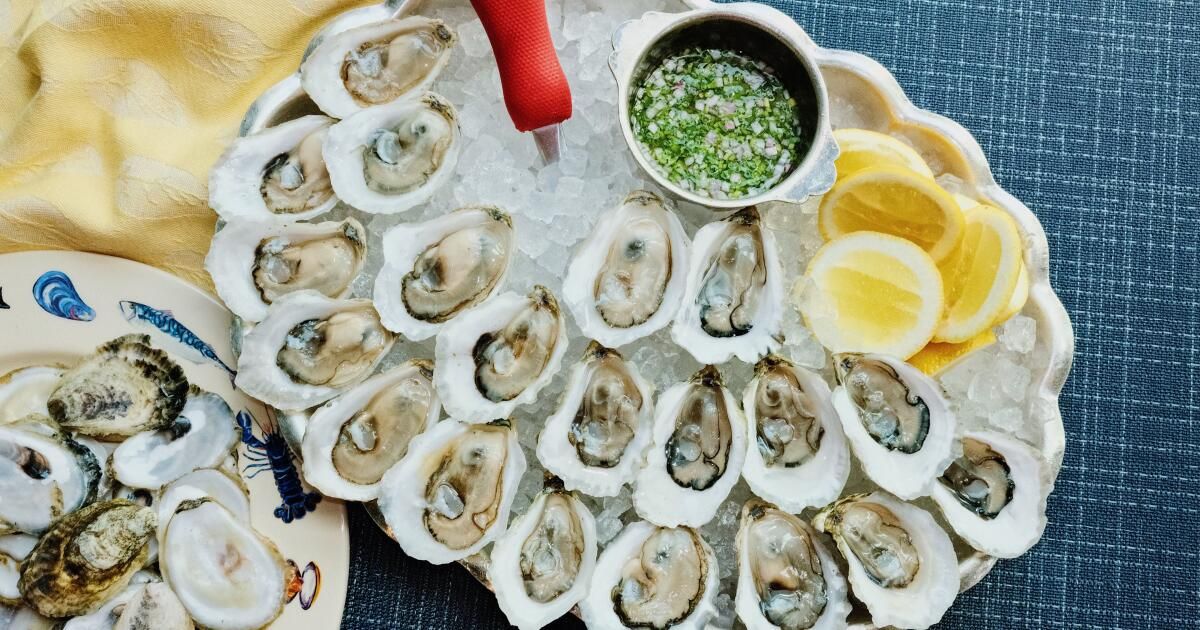Ari Kolender knows oysters. His two seafood restaurants, which are found in Oyster in East Hollywood and Queen's Raw Bar & Grill in Eagle Rock, serve tens of thousands of oysters per week. Among them they have sold more than one million oysters, extended in ice dishes, involved in seafood towers, raw, grilled or fried (even occasionally fried buffalo).
So, if you want to learn to discard oysters correctly, who better to ask what Kolender?
Yes, “the process is intimidating,” says Kolender. “You have a sharp knife. You have something fighting you. Do you use a glove? Do you use a towel? All this. How do I open this hinge?
“It is not easy, but if you know what you are looking for, it can be.”
Shuck quality is important, says Kolender. It is standing in the La Times test kitchen, equipped with a oyster knife and a thick cooking towel, about to open a couple of dozens of Oysters Hayes (west coast) and Norumbega (East Costa).
“Everyone thinks they should dig as much force as possible,” he says. “It's not about pressure, it's about leverage. You are trying to separate these two shells that open naturally.”
“Everyone thinks they should deepen as much force as possible,” says Ari Kolender, to open oysters. But it's about leverage.
(Stephanie Breijo / Los Angeles Times)
Here are Kolender's advice for perfectly shit oysters:
First, look for fresh and clean oysters. Always ask when they were harvested. “They can live a long time, but they begin to lose their infrastructure,” or their liquid, after a week.
You want closed oysters. If an oyster is open and remains open, it is dead and must be ruled out. If your liquor has spilled in other oysters, simply rinse them.
Ok, let's tear.

More oyster opening tips: use a kitchen towel. Do not think about the oyster knife like a chef knife. Pebble Ice is the best ice to serve oysters.
(Stephanie Breijo / Los Angeles Times)
Consider the anatomy of the oyster.
An oyster usually has a hollowed side and a flat side. The oyster cup should be looking down.
The side with hinges of the oyster reaches a point in a “V” the purpose here is to open the hinge, then release the oyster meat from the upper and lower cover, which is connected by its adductor muscle.
Use a kitchen towel to hold your oyster. “It's the safest way to be,” says Kolender.
Put the flat kitchen towel on a surface. Although Kolender prefers to hold the towel in his hand, he says that placing it on the counter, with the oyster resting on it, is the best way for beginners to get into the physics of the omission.
Make sure the oyster hinge faces you. “Your knife is designed to fit very well in a hinge,” he says. The hinge might not be in the same place every time. Pass your knife along the “V” -shaped end of the oyster and “will tell you where it should be. Determine how you feel comfortable.”
Open the hinge. Press down the oyster to keep it still, with a little pressure and then move the knife in a “u” rocker along the hinge. That creates friction and leverage between the upper housing and the lower housing, which opens it.
Release the adductor muscle that joins the meat to the peel. It goes directly through the upper and lower part of the oyster. His work is to release the oyster from the upper and lower shell and leave it there to serve.
Then you are going to pass the tip of the knife along the side of the housing so you can open it slightly, enough for you to see the oyster and identify its adductor muscle. “This is not your chef's knife. You are not cutting the peel meat. You're actually pushing the peel meat.” So keep the knife against the top of the peel and thrust to scrape the meat. It is surgery; It's just the tip of the knife you need. The upper part of the shell should leave.
The same process applies to eliminating the adductor muscle away from the lower housing. “I like to use my thumb as a board to keep the oyster in place.” Use the tip of your knife to follow the shape of the thread ahuecada, holding the knife against the peel to release the meat.
Additional tips: Remember to clean your knife as you advance. And clean any rubble of the housing that sustains the oyster.
Serve the plain oysters on ice. Kolender serves them on pebble ice, because “it is pleasant and light” and you can really stroke your oysters on the ice so that they keep plans, not inclined, so none of their liquids spills. Some fast food restaurants such as Chick-Fil-A and Sonic will sell you from pebbles, he says. You can use any type of ice. “The best thing to do with oysters is to keep them cold.”












